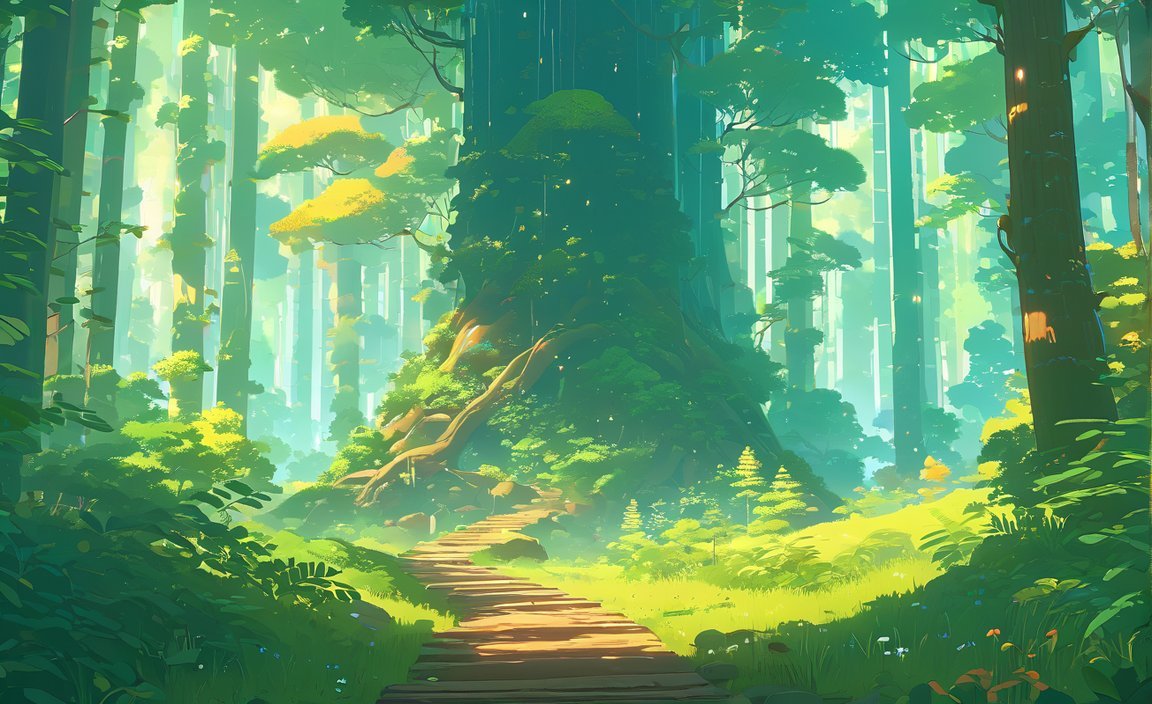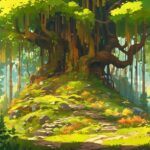Deciduous forests are one of the most widespread and diverse biomes on Earth. They are characterized by the presence of trees that lose their leaves seasonally, usually in autumn and winter. Deciduous forests can be found in temperate, subtropical, and tropical regions, and they host a rich variety of life forms. In this article, we will explore some of the biotic factors of deciduous forests, which are the living components of this ecosystem.

What are Biotic Factors?
Biotic factors are the living organisms that interact with each other and with the abiotic factors, which are the non-living elements of the environment, such as soil, water, air, light, and temperature. Biotic factors can be classified into different levels of organization, such as:
- Individuals: single organisms of the same species, such as a deer, an oak tree, or a mushroom.
- Populations: groups of individuals of the same species that live in the same area, such as a herd of deer, a stand of oak trees, or a cluster of mushrooms.
- Communities: groups of populations of different species that live in the same area and interact with each other, such as a forest community that includes deer, oak trees, mushrooms, and many other organisms.
- Ecosystems: groups of communities and the abiotic factors that affect them, such as a deciduous forest ecosystem that includes the forest community and the soil, water, air, light, and temperature of the area.
Biotic factors play a crucial role in the functioning and stability of an ecosystem. They are involved in various processes, such as:
- Energy flow: the transfer of energy from one organism to another through feeding relationships, such as producers, consumers, and decomposers.
- Nutrient cycling: the movement of nutrients from one organism to another and from the biotic to the abiotic components of the ecosystem, such as the carbon cycle, the nitrogen cycle, and the water cycle.
- Biodiversity: the variety and complexity of life forms in an ecosystem, which can affect the productivity, resilience, and adaptability of the ecosystem.
What are the Biotic Factors of Deciduous Forests?
Deciduous forests are home to a wide range of biotic factors, from microscopic bacteria to large mammals. Some of the main biotic factors of deciduous forests are:
- Plants: the primary producers of the ecosystem, which use photosynthesis to convert light energy into chemical energy. Plants provide food, oxygen, and shelter for other organisms, and they also influence the climate, soil, and water of the ecosystem. Some of the common plants in deciduous forests are:
- Trees: the dominant plants in deciduous forests, which form the canopy layer of the ecosystem. Trees lose their leaves seasonally to conserve water and energy during harsh conditions. Some of the typical trees in deciduous forests are oaks, maples, birches, beeches, and hickories.
- Shrubs: the woody plants that grow under the canopy layer, which form the understory layer of the ecosystem. Shrubs provide food and cover for many animals, and they also help prevent soil erosion and water loss. Some of the common shrubs in deciduous forests are blueberries, raspberries, honeysuckles, and rhododendrons.
- Herbs: the non-woody plants that grow on the forest floor, which form the herbaceous layer of the ecosystem. Herbs include grasses, ferns, wildflowers, and mosses, which add color and diversity to the ecosystem. Herbs also provide food and habitat for many insects, birds, and small mammals.
- Animals: the consumers and decomposers of the ecosystem, which use the energy and nutrients provided by the plants and other animals. Animals have various adaptations to cope with the seasonal changes in the ecosystem, such as hibernation, migration, and camouflage. Some of the common animals in deciduous forests are:
- Mammals: the warm-blooded vertebrates that have fur or hair and produce milk for their young. Mammals are the largest and most diverse group of animals in deciduous forests, and they occupy different trophic levels, such as herbivores, carnivores, and omnivores. Some of the typical mammals in deciduous forests are deer, squirrels, bears, foxes, and raccoons.
- Birds: the warm-blooded vertebrates that have feathers and wings and lay eggs. Birds are the most visible and vocal group of animals in deciduous forests, and they play important roles in pollination, seed dispersal, and pest control. Some of the common birds in deciduous forests are woodpeckers, robins, cardinals, and owls.
- Reptiles and amphibians: the cold-blooded vertebrates that have scales or moist skin and lay eggs. Reptiles and amphibians are the most sensitive group of animals in deciduous forests, and they indicate the health and quality of the ecosystem. Some of the common reptiles and amphibians in deciduous forests are snakes, turtles, frogs, and salamanders.
- Insects and other invertebrates: the animals that lack a backbone and have an exoskeleton or a soft body. Insects and other invertebrates are the most abundant and diverse group of animals in deciduous forests, and they perform vital functions in decomposition, nutrient cycling, and food webs. Some of the common insects and other invertebrates in deciduous forests are ants, bees, butterflies, spiders, and earthworms.
Why are the Biotic Factors of Deciduous Forests Important?
The biotic factors of deciduous forests are important for many reasons, such as:
- They provide essential ecosystem services, such as oxygen production, carbon sequestration, water purification, soil formation, and climate regulation.
- They support a high level of biodiversity, which enhances the productivity, resilience, and adaptability of the ecosystem.
- They offer various economic, social, and cultural benefits, such as food, medicine, timber, recreation, education, and inspiration.
However, the biotic factors of deciduous forests are also facing many threats, such as:
- Deforestation, which reduces the forest area and fragments the habitat of many organisms.
- Pollution, which contaminates the soil, water, and air of the ecosystem and affects the health and survival of many organisms.
- Climate change, which alters the temperature, precipitation, and seasonality of the ecosystem and affects the distribution and adaptation of many organisms.
- Invasive species, which compete with or prey on the native organisms and disrupt the balance and functioning of the ecosystem.
Therefore, it is important to conserve and protect the biotic factors of deciduous forests, as they are vital for the well-being of the ecosystem and the human society.
Discover an exciting world of knowledge about Geothermal Energy Fun Facts by clicking here. Unearth interesting insights into this sustainable energy source!
FAQ
Q: What are deciduous forests and where are they found?
A: Deciduous forests are ecosystems that are dominated by trees that lose their leaves seasonally, usually in autumn and winter. Deciduous forests can be found in temperate, subtropical, and tropical regions of the world, such as North America, Europe, Asia, and Australia. Deciduous forests cover about 10% of the Earth’s land surface.
Q: What are the biotic factors of deciduous forests and why are they important?
A: Biotic factors are the living organisms that interact with each other and with the abiotic factors, which are the non-living elements of the environment, such as soil, water, air, light, and temperature. The biotic factors of deciduous forests include plants, animals, and microorganisms, which form different levels of organization, such as individuals, populations, communities, and ecosystems. The biotic factors of deciduous forests are important for many reasons, such as:
- They provide essential ecosystem services, such as oxygen production, carbon sequestration, water purification, soil formation, and climate regulation.
- They support a high level of biodiversity, which enhances the productivity, resilience, and adaptability of the ecosystem.
- They offer various economic, social, and cultural benefits, such as food, medicine, timber, recreation, education, and inspiration.
Q: How do the biotic factors of deciduous forests adapt to the seasonal changes in the environment?
A: The biotic factors of deciduous forests have various adaptations to cope with the seasonal changes in heat, moisture, and food availability. Some of the common adaptations are:
- Hibernation: a state of reduced metabolic activity and body temperature, which allows some animals, such as bears, squirrels, and bats, to conserve energy and survive the winter.
- Migration: a movement of animals from one place to another, usually in response to changes in food or climate. Many birds, such as robins, cardinals, and geese, migrate south during winter and return north during spring.
- Camouflage: a coloration or pattern that helps an organism blend in with its surroundings and avoid predators or prey. Some animals, such as foxes, rabbits, and deer, change their fur color according to the season, while some plants, such as ferns, mosses, and wildflowers, grow in different shades of green, brown, or yellow.
- Dormancy: a state of reduced growth and development, which allows some plants, such as trees, shrubs, and herbs, to survive unfavorable conditions and resume activity when conditions improve. Some plants, such as oaks, maples, and birches, lose their leaves during winter and grow new ones during spring, while some plants, such as blueberries, raspberries, and honeysuckles, produce buds or seeds that can withstand cold and germinate when warm.
Q: What are some of the threats and challenges facing the biotic factors of deciduous forests?
A: The biotic factors of deciduous forests are facing many threats and challenges, such as:
- Deforestation: the clearing of forest land for agriculture, urbanization, logging, or mining, which reduces the forest area and fragments the habitat of many organisms.
- Pollution: the contamination of the soil, water, and air of the ecosystem by human activities, such as industrial waste, agricultural runoff, or vehicle emissions, which affects the health and survival of many organisms.
- Climate change: the alteration of the temperature, precipitation, and seasonality of the ecosystem by human-induced greenhouse gas emissions, which affects the distribution and adaptation of many organisms.
- Invasive species: the introduction of non-native organisms that compete with or prey on the native organisms and disrupt the balance and functioning of the ecosystem, such as the emerald ash borer, the gypsy moth, or the Japanese knotweed.
Q: How can we conserve and protect the biotic factors of deciduous forests?
A: We can conserve and protect the biotic factors of deciduous forests by:
- Reforestation: the planting of trees or seeds in areas that have been deforested or degraded, which can restore the forest cover and habitat of many organisms.
- Management: the regulation and monitoring of human activities that affect the ecosystem, such as logging, hunting, or farming, which can prevent overexploitation and ensure sustainable use of resources.
- Education: the raising of awareness and knowledge of the ecosystem and its importance, benefits, and threats, which can foster appreciation and responsibility among the public and the stakeholders.
- Research: the collection and analysis of data and information on the ecosystem and its biotic factors, which can improve understanding and decision-making for conservation and protection.
- Unveiling Bernhard Caesar Einstein’s Scientific Achievements: A Legacy in Engineering - July 15, 2025
- Uncover who is Jerry McSorley: CEO, Family Man, Business Success Story - July 15, 2025
- Discover Bernhard Caesar Einstein’s Scientific Contributions: Unveiling a Legacy Beyond Einstein - July 15, 2025















